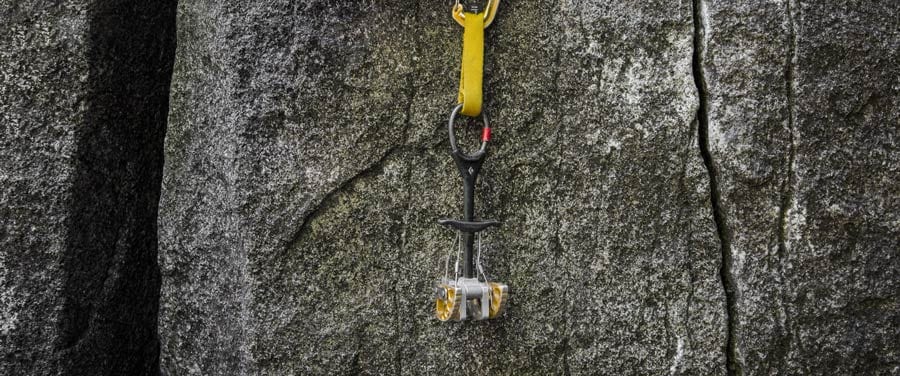If you have your sights set on becoming a trad climber, you'll need to get a wide range of protection gear (aka: "pro"). This includes passive pro (gear without moving parts) and active pro (gear with moving parts). In this article, we'll focus on active pro. (If you want help choosing passive pro, see our article on choosing nuts, stoppers and chocks.)
By far the most popular type of active pro is a cam. The less-common spring-loaded wedges are used by some experienced trad climbers.
As you shop for active pro, consider this:
Start with cams: The majority of experienced trad climbers carry a selection of cams on their rack. Though they are a bit pricey, cams are generally very easy to place, which makes them incredibly popular. As you shop for cams, pay attention to the number of cam lobes, stem design, number of axles and the expansion range.
Then add specialized gear: As you gain experience, you may want to add specialized gear like spring-loaded wedges to your rack.
Cams

Cams typically feature three or four curved pieces of aluminum, called cam lobes. When you pull the spring-loaded trigger wire, these chunks of metal retract and make the device narrower. This allows you to slide the unit inside a crack. When you release the trigger, the cam lobes expand to fit the rock. Placed correctly, cams offer excellent hold, particularly in places where passive pieces of gear will not, such as parallel-sided cracks.
When shopping for cams, pay attention to the following:
- Number of cam lobes
- Stem design
- Number of axles
- Expansion range
- Offset cams
Number of Cam Lobes
Most cams include either three or four individually spring-loaded cam lobes. When a climber falls and weights the cam, the downward force is transferred to the lobes, which push out on the rock to hold the cam in place.
Three-lobe cams
Pros:
- Narrower profile than cams with four lobes, which allows them to fit better in tight places, such as shallow cracks or pin scars (damaged sections of rock caused by the pounding in of pitons).
- Can also be less prone to "walking" (moving) out of position after being placed in a crack than cams with four lobes.
- Generally lighter than four-lobe cams.
Cons:
- Three lobes offer less contact with the rock, which can create a less secure placement.
Four-lobe cams
Pros:
- The standard among cams, the four-lobe design provides more contact with the rock than a three-lobe cam; this translates to a more secure placement.
Cons:
- Slightly heavier and bulkier than three-lobe cams.
- Most have a wider profile that doesn't fit as well in smaller, shallower cracks.

Stem Design
It used to be that cams had rigid stems. Although they were very durable, their rigidity made them problematic in some placements, especially in horizontal cracks. Today, cams come with flexible stems that bend when you weight them. These work great with cam placements in horizontal cracks. There are two primary designs for flexible stems:
Single-Cable Stems

Pros:
- Single cable stems are slim enough to fit in narrow cracks or oddly-shaped pockets where other wider stems won't work.
- Climbers with large hands often find single-stem cams easier to operate than U-stem cams.
Cons:
- To pull the trigger on a single-cable stem, you'll typically need to use your forefinger, middle finger and thumb, as opposed to a U-stem cam that can be operated with one finger and thumb.
U-Stems

Pros:
- The trigger on flexible U-shape stems can easily be operated with the forefinger and thumb.
- Some climbers find them easier to retract evenly than single-stem cams.
Cons:
- The larger profile of the U-stem can make it difficult to fit the cam into small spaces.
- Some climbers find it difficult to get their thumbs in the curved portion of the smaller-size cams.
With any cam, it's best to get it in your hands and decide for yourself which trigger action is the most comfortable. Comfort and ease of use can make a difference when you're trying to place them quickly with one hand.
Number of Axles

There are advantages and disadvantages to each design:
Double axle
Pros:
- The primary advantage of a cam with a double axle is the greater expansion range.
- Double-axle cams also tend to be a bit stronger than single-axle cams.
Cons:
- The extra axle brings additional weight, making most double-axle cams a tad heavier.
Single axle
Pros:
- Single-axle cams are typically lighter than double-axle cams.
Cons:
- They sacrifice a bit of expansion range and strength compared to double-axle cams.
Expansion Range
One of the finer details to pay attention to is expansion range of a cam. This is the range that the cam expands from when the lobes are fully contracted to fully expanded.
A cam with a large expansion range can fit in more places than a cam with a smaller expansion range. Therefore, choosing cams with larger expansion ranges can allow you to carry fewer cams while still being able to protect the same size range of cracks as you would if you carried more cams with smaller expansion ranges. Carrying fewer cams keeps your rack lighter.
Check the specs tab on REI.com product pages to see the expansion range for each cam.
Offset Cams

Standard cams feature evenly sized and shaped cam lobes. Some manufacturers make offset cams that have two larger lobes and two smaller lobes. The idea behind offset cams is that the different sized lobes enable the cam to sit securely in non-uniform cracks, such as cracks that flare inward or outward, or in pin scars (damaged sections of rocks created by the pounding in of pitons).
Most trad climbers will build a rack with regular (non-offset) cams and then add offset cams if the places they climb require them. Some climbing areas, such as Yosemite, are well known to have cracks that readily accept offset cams. If you aid climb, offset cams can be especially useful because you'll often be placing gear in pin scars left by pitons.
Spring-Loaded Wedges

These pieces of active protection have a small sliding piece that expands the size of the wedge once it is placed in a crack. Similar to placing a cam, you pull the spring-loaded trigger to retract the sliding piece, place the wedge into a narrow crack, then release the trigger to allow the sliding piece to return to its original position. The sliding piece presses against the rock and the larger piece of the wedge to hold it in position.
Pros:
- Can fit in small, parallel-sided cracks where no other cam or nut will.
- The small sizes have a higher strength rating than comparably sized cams.
- They are lighter than many comparably sized cams.
Cons:
- Can be difficult to clean (remove from a crack).
- Because of their small size, they may not hold as well as a larger passive nut.
- Like cams, the spring-loaded design can allow them to "walk" inside the crack after you place them.
- Less versatile than cams and nuts.
Your climbing safety is your responsibility. No article or video can replace proper instruction and experience. Make sure you practice the proper techniques and safety guidelines before you climb.
